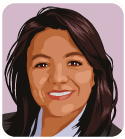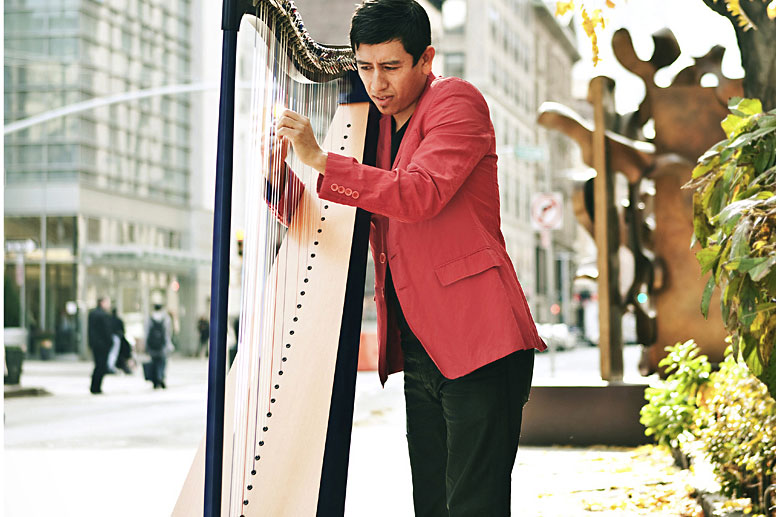*Read a transcript of AQ‘s interview with Edmar Castañeda below.
Edmar Castañeda can boast not just one, but two accomplishments that most musicians only dream of. The 33-year-old Colombian harpist has introduced international audiences to a distinctly South American musical style—joropo—and he has broken new ground in jazz. Castañeda is first and foremost a performer of joropo, also known as música llanera for the plains (llanos) on which it was originally played. Joropo resembles the waltz and combines Iberian music from the 17th and 18th centuries with African and Indigenous rhythms native to the Orinoco basin. He is also a New York jazz musician who plays the harp—an unconventional instrument in a genre traditionally defined by the piano, brass and woodwind instruments.
Castañeda grew up in Bogotá. When he was six years old, his mother enrolled him and his sister in a dance institute, where he learned the joropo dance. His father also taught him to play the harp and the cuatro guitar. But Castañeda’s musical pursuits would have ended there if not for another family member. “My aunt had a harp at home and I always went to her place and begged her to let me play it,” he recalls. One day, impressed by Castañeda’s playing, she gave him the instrument.
At the age of 16, Castañeda moved to New York, where he was first introduced to jazz. “I was attracted to it because it’s very similar to llanera music,” he says. “They don’t sound the same but in both genres you improvise.”
Castañeda cites Chick Corea and Charlie Parker as his major influences, but he likes to listen to a variety of musicians, including Astor Piazzolla, Igor Stravinsky and Frederic Chopin.
While playing harp solos at a restaurant—a gig he got to make money while studying music at Five Towns College in Dix Hills, New York—Castañeda practiced and experimented with different sounds and techniques. During that time, he created what he considers his signature style—playing the melody and bass simultaneously. “With my left hand I play the bass and the groove, and with my right hand I play the melody and harmony,” he explains. “If you close your eyes you can hear two or three instruments playing at the same time.”
When he was 20, Edmar began attending improvisational jam sessions, or descargas, in New York City. He often went to see Nelson González, a renowned Puerto Rican tres guitar player, and once offered to sit in during a performance. Though González was skeptical, thinking the harp was too big for the stage and would be out of place in a descarga, the performance was a success.
After that, Edmar’s career took off. Today, he has even designed his own harp—complete with an engraved “EC Llanera” logo—which is produced and sold by the French company Camac Harps.
Castañeda’s albums are a mélange of genres, instruments and cultures that draw upon the diverse work of individuals he has met in the U.S.—including his wife Andrea, a paisa (a native of Antioquia province in northwest Colombia), whom he married one month after they met at a musical tertulia session in Queens, New York. Edmar’s first album, Cuarto de Colores– (2005), was inspired by the colors in Andrea’s bedroom. It combines typical joropo sounds—evoking the galloping pace of a runaway horse—the essential beats of flamenco and mambo and the harmonious disorder of jazz. Cuarto was followed by Entre Cuerdas (2009), which explores interactions between the trombone, drums and harp, and on which Andrea—a poet and daughter of traditional Colombian troubadours (troveros)—sings over the instruments.
In his most recent album, Double Portion, which was released in December 2011, Castañeda plays with Gonzalo Rubalcaba, a piano player from Cuba; Hamilton de Holanda, a Brazilian mandolin player; and Miguel Zenón, a new saxophone player from Puerto Rico. Though he says joropo is at the root of everything he does, he calls the mix of instruments and players on Double Portion “the perfect seasoning for my Colombian plate.”
AQ Interview: Colombian Harpist Edmar Castañeda
Interview by Lina Salazar (Redacted transcript)
AQ: What is your background, and when did you start playing music?
EC: I’m from Bogotá, Colombia. I was born in March 1978, and both of my parents are from Bogotá.
I started playing the harp when I was 13. Actually, at 7, I started learning to dance the joropo with my sister. That’s where I was first introduced to the harp and fell in love with it. My dad’s a harpist too, and an educator—he taught me to play the cuatro guitar. But I was very poor in Colombia, and I never had the opportunity to have a harp—until I was 13. My aunt had a harp, and I used to go to her place and say, “Let me play, let me play.” She did, and then one day, she just said, “Take it,” and I [didn’t think twice].
At 16 I moved to New York. My dad came two years before—he was separated from my mom since I was little—and then he brought my sister and me here so we could have better opportunities. It was in New York that I first heard jazz. I was attracted to it because it’s very similar to llanera music; they don’t sound the same but in both genres you improvise. Then in college, I studied trumpet and jazz. I received my Bachelors degree in music from Five Towns College, a private school for music in Long Island.
AQ: Who were your main influences?
EC: Some of my influences are Chick Corea and Charlie Parker. But I always listen to different musicians such as Astor Piazzolla, Lucho Bermudez, Paco de Lucía, Stravinsky, and Chopin.
AQ: What happened after you graduated?
EC: I graduated from college as a trumpet performer, but I never stopped playing the harp; instead, I translated what I learned in the trumpet to the harp. I wanted to get the feeling of playing with a big band, of improvising, so I started attending jam sessions—descargas. There was a place called Nell’s that I used to go to a lot.
Often I went to see Nelson González. Once, I asked him if I could sit in with his band and play. He asked me what I played, and when I told him the harp, he asked if I had anything smaller. But we just tried it out, and people loved it, so I started coming every week. Then I met Paquito de Rivera, and he has been like a godfather to me.
AQ: How did you form your band, and when did you decide to combine joropo and jazz?
EC: Well, I started playing with different people, looking for different elements to complement my harp and jazz background. And joropo is at the root of everything I do—even if I play salsa, I put some joropo in. But I use samba, too, and African elements. I found a drummer and a trombone player, and that’s how the original trio started six years ago. I recorded my first album Cuarto de Colores, which was inspired by my wife’s colored bedroom. Then came Entre Cuerdas, released in 2009, where I play in a trio of trombone, drums and harp.
One of my best experiences was playing in Poland. I played with Marcus Miller, a great bass player…it was amazing. There was a crowd of 15,000 people there.
My upcoming album, Double Portion, is a solo album. I play both the Colombian harp and the classical harp, used in orchestra concerts. I have a couple of special guests—Gonzalo Rubalcaba, a piano player from Cuba; Hamilton de Holanda, a Brazilian mandolin player; and Miguel Zenón, a new saxophone player from Puerto Rico. It’s a mix of Latin American musicians—the perfect sazón for my Colombian plate.
AQ: Your wife sings in your most recent album, Entre Cuerdas. When did you meet her and how did she end up working with you?
EC: I met my wife at a jam session in Queens—a sort of tertulia, with different musicians, poets, etc. After 20 days or a month, we got married; I just knew she was the one. We’ve been married for seven years and have two kids, Zamir and Zeudi.
She’s from Medellín—her family members are troveros. We started working together right away. We combined her poetry and talent with my ideas. Working with her is the most amazing thing. I love it because we share very special moments, and also it makes your message stronger. Her voice is very powerful—you can hear her passion.
AQ: What has been most difficult in your musical career?
EC: Everything has just been a process. When I was in college, I had a gig every day at a restaurant playing solo harp, so that was for me a kind of harp school. They let me do whatever I wanted, so that’s how I learned. I was a solo harpist, so I had to learn to play the different kinds of music that people wanted to hear. That’s how I created my style of playing the bass with the harp: I play the bass and groove with my left hand, and play the melody and harmonies with my right…If you close your eyes, it sounds like 2 or 3 instruments playing at the same time.
AQ: What’s your inspiration? Is there a message that you try to communicate in your music?
EC: God and my family are my inspiration; it’s a gift from God to be able to play the harp. I believe that music can change lives and I pray that through those strings people get in touch with the love of God. I believe that when you obey and follow God he always gives you a “double portion” of blessings…that’s why my album is called Double Portion.
AQ: Do you feel connected to your Colombian identity when you play?
EC: Yes, definitely. Everywhere I go I invite people to visit our country. The times I’ve visited Colombia with the band the musicians have fallen in love with the country and the country has fallen in love with our music. I’ve played in Colombia four or five times—in different cities such as Villavicencio, the home of llanera music.
AQ: What are your future projects?
EC: 2011 was a very busy year. I want to take a bit of a break. Currently I’m writing a symphony piece for orchestra and harp using llanera music. I’m also planning to record an album with a big band—and I’m getting married by church with my wife!




